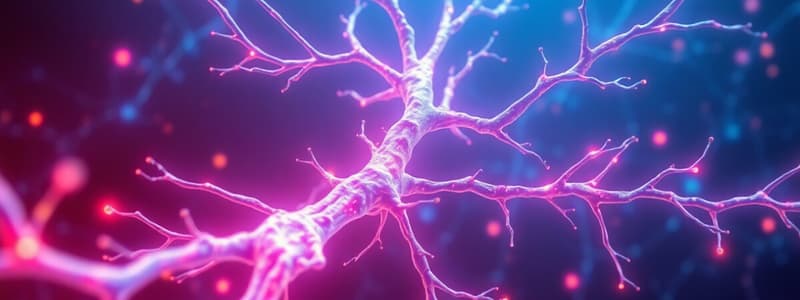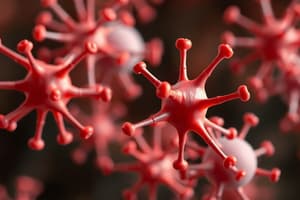Podcast
Questions and Answers
What is the primary function of the autonomic nervous system?
What is the primary function of the autonomic nervous system?
- To transmit sensory information to the brain
- To regulate muscle contractions
- To facilitate conscious movement
- To control involuntary bodily functions (correct)
Which division carries impulses toward the central nervous system (CNS)?
Which division carries impulses toward the central nervous system (CNS)?
- Autonomic division
- Afferent division (correct)
- Somatic division
- Efferent division
Which type of sensory fibers transmit impulses from the skeletal muscles?
Which type of sensory fibers transmit impulses from the skeletal muscles?
- Somatic sensory fibers (correct)
- Efferent fibers
- Visceral sensory fibers
- Afferent fibers
What do visceral sensory fibers transmit impulses from?
What do visceral sensory fibers transmit impulses from?
Which function is NOT associated with the autonomic nervous system?
Which function is NOT associated with the autonomic nervous system?
What type of fibers carry impulses from the body's sensory receptors to the brain?
What type of fibers carry impulses from the body's sensory receptors to the brain?
What primarily maintains blood pressure through partial constriction of blood vessels?
What primarily maintains blood pressure through partial constriction of blood vessels?
What is the resting heart rate maintained by parasympathetic tone?
What is the resting heart rate maintained by parasympathetic tone?
In the nervous system, where do efferent fibers transmit impulses?
In the nervous system, where do efferent fibers transmit impulses?
What happens to the heart rate if the vagus nerve is cut?
What happens to the heart rate if the vagus nerve is cut?
What is the relationship between the autonomic nervous system and its sensory divisions?
What is the relationship between the autonomic nervous system and its sensory divisions?
What condition occurs due to the withdrawal of parasympathetic tone?
What condition occurs due to the withdrawal of parasympathetic tone?
Which of the following best describes dual innervation?
Which of the following best describes dual innervation?
How do sympathetic and parasympathetic innervations usually operate in organs?
How do sympathetic and parasympathetic innervations usually operate in organs?
What role do parasympathetic fibers play in the reproductive system?
What role do parasympathetic fibers play in the reproductive system?
What is the consequence of a loss of autonomic tone?
What is the consequence of a loss of autonomic tone?
What is the function of the Sympathetic Nervous System?
What is the function of the Sympathetic Nervous System?
Which part of the autonomic nervous system is associated with the cranial and sacral nerves?
Which part of the autonomic nervous system is associated with the cranial and sacral nerves?
What are the receptors that receive acetylcholine called?
What are the receptors that receive acetylcholine called?
What type of outflow is associated with T1 to L2 vertebral levels?
What type of outflow is associated with T1 to L2 vertebral levels?
Which nervous system primarily promotes the rest and digest functions in the body?
Which nervous system primarily promotes the rest and digest functions in the body?
What type of receptors are involved in receiving the neurotransmitter acetylcholine?
What type of receptors are involved in receiving the neurotransmitter acetylcholine?
Which of the following statements is true about the autonomic nervous system?
Which of the following statements is true about the autonomic nervous system?
Which of the following best describes the main distinction between the sympathetic and parasympathetic nervous systems?
Which of the following best describes the main distinction between the sympathetic and parasympathetic nervous systems?
What primary role does the autonomic nervous system (ANS) serve?
What primary role does the autonomic nervous system (ANS) serve?
Which of the following organs is NOT directly regulated by the autonomic nervous system?
Which of the following organs is NOT directly regulated by the autonomic nervous system?
What is the time frame for the autonomic nervous system to approximately double arterial blood pressure?
What is the time frame for the autonomic nervous system to approximately double arterial blood pressure?
Where are the major control centers for the autonomic nervous system located?
Where are the major control centers for the autonomic nervous system located?
Which of the following is one of the functions regulated by the autonomic nervous system?
Which of the following is one of the functions regulated by the autonomic nervous system?
How does the autonomic nervous system primarily affect visceral organs?
How does the autonomic nervous system primarily affect visceral organs?
Which of the following systems does the autonomic nervous system NOT primarily regulate?
Which of the following systems does the autonomic nervous system NOT primarily regulate?
What is one characteristic of the responses regulated by the autonomic nervous system?
What is one characteristic of the responses regulated by the autonomic nervous system?
What type of receptors are nicotinic receptors classified as?
What type of receptors are nicotinic receptors classified as?
Which receptor is NOT associated with the sympathetic nervous system?
Which receptor is NOT associated with the sympathetic nervous system?
Which neurotransmitter is primarily associated with the sympathetic nervous system?
Which neurotransmitter is primarily associated with the sympathetic nervous system?
What is a characteristic of the parasympathetic nervous system?
What is a characteristic of the parasympathetic nervous system?
Which receptors cause vasodilation?
Which receptors cause vasodilation?
What is the only exception to the cholinergic receptors in the sympathetic system?
What is the only exception to the cholinergic receptors in the sympathetic system?
In what manner does the sympathetic nervous system typically function?
In what manner does the sympathetic nervous system typically function?
Which pathways suggest autonomic tone involves some contraction?
Which pathways suggest autonomic tone involves some contraction?
Which cranial nerve is known for having widespread influence throughout the body?
Which cranial nerve is known for having widespread influence throughout the body?
What effect does the sympathetic nervous system have on blood vessels?
What effect does the sympathetic nervous system have on blood vessels?
Flashcards are hidden until you start studying
Study Notes
Cholinergic Receptors
- There are two types of cholinergic receptors
- Nicotinic receptors
- Muscarinic receptors
- Nicotinic receptors have five categories
- Muscarinic receptors have five categories:
- M1: glands
- M2: heart
- M3: eyes: rotate
- M4: CNS
- M5: CNS
Sympathetic Nervous System
- Sympathetic nervous system is also known as the "fight or flight" system
- Uses norepinephrine (NE) as a chemical messenger
- Beta 1: heart
- Alpha: Causes vasoconstriction by contracting muscles around blood vessels
- Betaz: causes vasodilation
Autonomic Efferent Pathways
- Sympathetic - Thoraco-lumbar outflow (T1-L2)
- Uses acetylcholine (ACh) as a chemical messenger
- Parasympathetic - Cranio-sacral outflow
- Uses acetylcholine (ACh) as a chemical messenger
- Cranial nerves and sacral nerves
- Vagus nerve (CN X) goes everywhere
Autonomic Efferent Pathways Continued
- Parasympathetic uses ACh, Sympathetic uses ACh and NE.
General Characteristics of the Parasympathetic and Sympathetic Nervous Systems
- Parasympathetic has widespread effects
- Sympathetic usually has localized responses
General Concepts for Autonomic Function - Autonomic Tone
- Autonomic motor neurons have a resting level of spontaneous activity, even when there are no stimuli. This is called autonomic tone.
- Autonomic tone can increase or decrease the activity of an autonomic nerve, allowing for better control.
Sympathetic tone
- Keeps most blood vessels partially constricted (50% in arterioles)
- Maintains blood pressure
Parasympathetic tone
- Keeps the heart rate between 70-80 beats per minute
- Provides background GI activity
- If the Vagus nerve was cut, the heart rate would be 100 beats per minute
General Concepts for Autonomic Function - Dual Innervation
- Most organs have both sympathetic and parasympathetic innervation
- These innervations operate reciprocally or synergistically to produce coordinated responses.
General Structure of the Nervous System
- The sensory division carries impulses toward the CNS from the body's sensory receptors.
- Somatic sensory fibers transmit impulses from the joints, skeletal muscles, and skin.
- Visceral sensory fibers transmit impulses from the visceral organs of the ventral body cavity.
- The motor division carries impulses from the CNS to effectors (muscles and glands).
- Somatic nervous system governs voluntary contractions of skeletal muscles.
- Autonomic nervous system controls involuntary functions of smooth muscle, cardiac muscle, and glands.
Autonomic Nervous System
-
The autonomic nervous system is an involuntary system that controls and modulates functions of visceral organs.
-
Axons travel to the periphery and synapse on ganglia.
-
Controls:
- Arterial pressure
- Bladder emptying
- Sweating
- Body temperature
- Cardiovascular and respiratory systems
- GI,
- Exocrine and some endocrine glands
-
Response is rapid:
- 3-5 seconds to increase heart rate
- 10-15 seconds to double arterial blood pressure
-
Controlled by centers in the:
- Spinal cord
- Brainstem
- Hypothalamus
- Limbic system
- Frontal lobes
-
All of these centers are concerned with arousal and behavioral responses to threat.
Sympathetic and Parasympathetic Nervous Systems
- Sympathetic - rest and digest
- Thoraco-lumbar outflow (T1-L2)
- Uses acetylcholine (ACh) as a chemical messenger.
- Receptors receiving acetylcholine are called cholinergic receptors.
- Parasympathetic - fight or flight (skull and sacrum)
- Cranio-sacral Outflow
- Uses acetylcholine (ACh) as a chemical messenger.
- Cranial nerves and sacral nerves.
- Vagus nerve (CN X) goes everywhere.
Studying That Suits You
Use AI to generate personalized quizzes and flashcards to suit your learning preferences.




